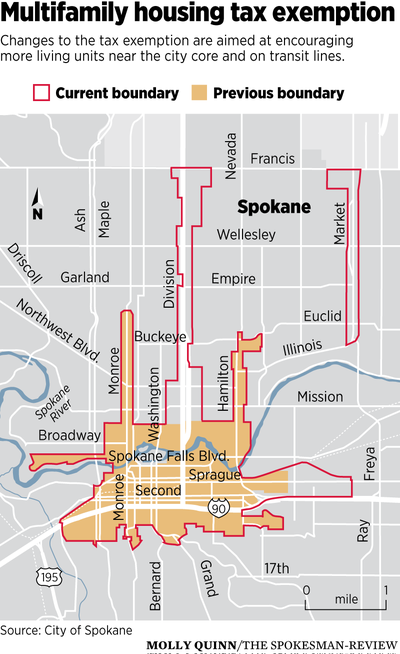Seeking to meet demand, city expands tax exemption for multifamily housing

Hoping to tie a surging demand for more apartment units in Spokane with a desire for density, the Spokane City Council approved changes to a city tax law this week aimed at spurring construction of more multifamily housing structures.
The changes to the Multiple Family Housing Tax Exemption expand the boundaries where the exemption can be used, and aligns the boundaries with land identified by the city to be prime for denser development. The changes also increase the income levels required under the exemption.
“This will help us to continue building the city from the core out,” said Councilwoman Candace Mumm.
The exemption applies to the construction or rehabilitation of a building that has four or more living units. Under the exemption, the land is fully taxed, but any new improvements related to housing are exempt from property taxes. After the exemption ends, taxes are paid on the property’s full value. The exemption stays with the property even if it’s sold.
There are many hurdles to clear before a developer can receive the exemption, including approval by the City Council.
It is the third time the exemption has been modified since it was created in 2000 to encourage more people to live downtown and in several neighborhood business districts throughout the city. The law was reauthorized in 2007 and changed to encourage projects in which at least 20 percent of units would be affordable and aimed at households making 115 percent of the area’s median income.
In 2012, the law was tinkered with again, this time shrinking its boundaries to the city’s core, a reaction to developers using the law to build massive complexes on the fringes of town. Notably, two large apartment complexes with nearly 300 units were built using the subsidies in the North Indian Trail neighborhood. The 2012 tax bill for the development was about $20,000 instead of $283,000.
At the time, the City Council also brought the qualifying income levels down sharply. With those changes, to receive a 12-year tax exemption, 20 percent of units had to be aimed at households earning just 50 percent of area median income.
Nobody has applied for the exemption since those changes were made.
“No projects were built,” said Teri Stripes, a city planner. “It was an ineffective tool.”
Council President Ben Stuckart, who was on the council in 2012, said the idea was to use the tax exemption as “a tool for affordable housing” in the aftermath of the recession.
“The fact that in five years nobody used it showed it isn’t the right tool for affordable housing,” he said. “It’s a multifamily housing tool.”
Stuckart said the exemption still encourages affordable workforce housing, just not for the poorest. Other programs are better suited for that goal, namely those through the Federal Housing Administration, but he said he was working on other local measures to address the “massive inequality in our society.”
On Monday, the council voted to bring the income levels back up to 115 percent of area income, and again look at the map where the projects should be encouraged.
Instead of the city’s centers and corridors, where it originally focused, or just in the city’s core, the city identified areas that had a lot of vacant or “underutilized” properties, or were part of a busy transit route, and made those areas where the exemption could be applied.
“We really wanted to make sure there would be transit available on a frequent basis to service these areas,” Mumm said.
The tax exemption now encompasses downtown, the University District, the East Sprague Avenue area just south of the University District, Kendall Yards, the North Monroe corridor, the Market corridor, the Division corridor, the Hamilton-Nevada corridor, the East Sprague Targeted Investment Pilot area and the lower South Hill.
John Dietzman, a member of the Plan Commission and former chair of the Indian Trail Neighborhood Council who was instrumental in developing the new rules, said it makes sense for a city to encourage people to live closer to the core in established urban areas, due to the existing utility infrastructure.
“It’s a general philosophy that you have jobs and utilities and streets and all the things you need closer to the core. So almost all cities are trying to do that: regenerate their inner core. Kendall Yards is a prime, shining example,” Dietzman said. “It’s been cheaper to build out in a virgin field. That’s why we have this incentive.”